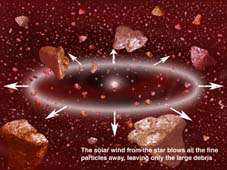Dusting for Clues: Gemini Discovers Evidence for Recent Planet-Forming Collisions around Nearby Star

Astronomers using the Gemini South 8-meter telescope in Chile have observed new details in the dusty disk surrounding the nearby star Beta Pictoris which show that a large collision between planetary-sized bodies may have occurred there as recently as the past few decades.
Image: The solar wind from the star blows all the fine particles away, leaving only the large debris(by Jon Lomberg)
The mid-infrared observations provide the best evidence yet for the occurrence of energetic encounters between planetesimals (small bodies formed of rock or ice) during the process of planetary formation. Amazingly, the observations even allow speculation as to when the event might have happened.
"It is as if we were looking back about 5 billion years and watching our own solar system as it was forming into what we see today," said Dr. Charlie Telesco of the University of Florida who led the team. "Our research is a bit like a detective dusting for fingerprints to figure out a crime scene, only in this case we use the dust as a tracer to show what has happened within the cloud. The properties of the dust show not only that this was a huge collision, but that it probably happened recently in both astronomical and even on human timescales."
The team's data revealed a significantly higher concentration of small dust grains in one region of the debris disk that gave the Beta Pictoris a lopsided appearance in previous observations. Dr Mark Wyatt, of the UK Astronomy Technology Centre in Edinburgh, has been modelling the structure of Beta Pictoris' dust disk, to understand the observations. He explains: "When a collision occurs, dust that is as fine as that we are seeing is rapidly blown away from the star, like ash from the charred remains of a fire. The fact that we can still see so much fine dust in this region means that it must have been produced very recently."
Disks of material surrounding stars such as Beta Pictoris are thought to contain objects of all sizes, from small dust grains similar to household dust to large planetesimals, or developing planets. As all of these objects orbit around the star, just like the Earth circles the Sun, they occasionally collide. The largest of these catastrophic encounters leave behind tell-tail debris clouds of fine dust observable at infrared wavelengths. By collecting high-resolution images from across a broad swath of the thermal infrared part of the spectrum, the research team from the U.S., UK and Chile analyzed images of a cloud in the larger Beta Pictoris disk which has properties expected in a post-collision aftermath.
A collision similar to that proposed here may well have created our own Moon several billion years ago when a Mars-sized body collided with what would eventually become the Earth. While the Moon itself formed out of large rocks and debris created by the collision, the small dust particles were blown away by radiation pressure from the young Sun. In the Beta Pictoris system radiation from the central star blows at about 30 times the intensity of the Sun, clearing out small grains even more quickly.
Because the Beta Pictoris disk appears to us edge-on, the observed asymmetry is visible as a bright "clump" in the cigar-shaped cloud of material revolving around the central star. The Gemini images also reveal new structures in the disk that might show where planets are forming in the system. The team is still studying these features, and follow-up observations are planned using Gemini South's newly silver-coated 8-meter mirror. This silver coating (now on both Gemini instruments) makes the twin telescopes the most powerful facilities on Earth for this type of infrared research.
Beta Pictoris was one of the first "circumstellar" disks discovered by astronomers. It was initially detected in IRAS (Infrared Astronomy Satellite) data in 1983 by Fred Gillett (formerly Gemini's Lead Scientist) and then imaged by Bradley Smith and Richard Terrile. Its lopsided nature was apparent even then, but until recently, observations yielded insufficient data at high-enough resolutions to allow a complete inventory of the dust grain size and distribution in the cloud. These recent Gemini results are a first step toward accomplishing that goal.
The Gemini data were obtained using the Gemini Thermal-Region Camera Spectrograph (T-ReCS) on the Gemini South Telescope on Cerro Pachón in Chile.
The international team published their findings and conclusions in the January 13 issue of the journal Nature and at the 205th meeting of the American Astronomical Society in San Diego California.
Gemini
The Gemini Observatory provides the astronomical communities in each partner country with state-of-the-art astronomical facilities that allocate observing time in proportion to each country's contribution. In addition to financial support, each country also contributes significant scientific and technical resources. The national research agencies that form the Gemini partnership include: the US National Science Foundation (NSF), the UK Particle Physics and Astronomy Research Council (PPARC), the Canadian National Research Council (NRC), the Chilean Comisión Nacional de Investigación Cientifica y Tecnológica (CONICYT), the Australian Research Council (ARC), the Argentinean Consejo Nacional de Investigaciones Científicas y Técnicas (CONICET) and the Brazilian Conselho Nacional de Desenvolvimento Científico e Tecnológico (CNPq). The Observatory is managed by the Association of Universities for Research in Astronomy, Inc. (AURA) under a cooperative agreement with the NSF. The NSF also serves as the executive agency for the international partnership.
Source: PPARC

















